Chemistry > QUESTIONS & ANSWERS > Questions and Answers > Texas State University - AP Chemistry CHEMISTRY 1310. Unit 9 Progress Check: (All)
Questions and Answers > Texas State University - AP Chemistry CHEMISTRY 1310. Unit 9 Progress Check: MCQ. 30 Questions and Answers.
Document Content and Description Below
AP Chemistry Scoring Guide Unit 9 Progress Check: MCQ Copyright © 2020. The College Board. These materials are part of a College Board program. Use or distribution of these materials online or in p... rint beyond your school’s participation in the program is prohibited. Page 1 of 21 Table 1 Cell Type | Operating Cell Potential for Commercial Batteries, Lithium-iodine Zinc-mercuryTable 2 Half-Reaction | Standard Reduction Potential,Pacemakers are electronic devices that help regulate the heart rate. Currently, lithium-iodine cells are commonly used to power pacemakers and have replaced zinc-mercury cells. Table 1 provides the operating cell potential, , for each cell. Table 2 provides the standard reduction potentials for several half-reactions related to zinc-mercury and zinc-air cells. 1. Based on the information given, which of the following is a major difference between the zinc-mercury cell and the lithium-iodine cell? A During the initial cell operation, each reaction is thermodynamically favorable, but the larger operating potential of the lithium-iodine cell indicates that its cell reaction is less thermodynamically favorable. B During the initial cell operation, each reaction is thermodynamically favorable, but the larger operating potential of the lithium-iodine cell indicates that its cell reaction is more thermodynamically favorable. C During the initial cell operation, the oxidation of iodine is thermodynamically favorable but the oxidation of mercury is not. D During the initial cell operation, the oxidation of mercury is thermodynamically favorable but not the oxidation of iodine is not. AP Chemistry Scoring Guide Unit 9 Progress Check: MCQ Copyright © 2020. The College Board. These materials are part of a College Board program. Use or distribution of these materials online or in print beyond your school’s participation in the program is prohibited. Page 2 of 21 2. On average, after one year of operation, the potential of a lithium-iodine cell decreases by 1%-2%. Which of the following best helps to explain the cause for the decrease in cell potential? A , and as the cell operates, decreases. B , and as the cell operates, increases. C , and as the cell operates, decreases. D , and as the cell operates, increases. 3. The use of zinc-mercury cells in hearing aids has been replaced by zinc-air cells that operate using the oxidation of by from the air, generating a potential of . Table 2 provides the standard reduction potentials for the half-reactions used in zinc-mercury and zinc-air cells. Which of the following best explains the modification to the cell design that is mostly responsible for the difference in standard cell potentials for zinc-mercury and zinc-air cells? A The greater standard cell potential of the | cell compared to that of the zinc-mercury cell most likely results from the thermodynamically more favorable reduction of compared to | .B The greater standard cell potential of the results from the greater number of moles of | cell compared to that of the zinc-mercury cell most likely required to reduce compared to | .C The greater standard cell potential of the | cell compared to that of the zinc-mercury cell most likely results from the thermodynamically less favorable reduction of compared to | .D The greater standard cell potential of the cell compared to that of the zinc-mercury cell most likely results from the greater number of moles of hydroxide ions required to reduce . | compared to AP Chemistry Scoring Guide Unit 9 Progress Check: MCQ Copyright © 2020. The College Board. These materials are part of a College Board program. Use or distribution of these materials online or in print beyond your school’s participation in the program is prohibited. Page 3 of 21 4. The diagrams above represent physical changes for potassium. Which of the following correctly identifies the physical process and provides the correct for the process in the indicated diagram? A In diagram 1, the process is freezing and is negative. B In diagram 2, the process is melting and is negative. C In diagram 3, the process is boiling and is negative. D In diagram 4, the process is condensation and is positive. 5. Two samples containing an equal number of moles of | are kept inside separate 1-liter rigid containers. The particle diagrams above show the distribution of molecular speeds in each sample. Based on the information given, which of the following identifies the sample with the greater | , and why? AP Chemistry Scoring Guide Unit 9 Progress Check: MCQ Copyright © 2020. The College Board. These materials are part of a College Board program. Use or distribution of these materials online or in print beyond your school’s participation in the program is prohibited. Page 4 of 21 A Sample 1, because the molecules collide less frequently compared to sample 2. B Sample 1, because the molecules have a larger distribution of energies compared to sample 2. C Sample 2, because the molecules collide more frequently compared to sample 1. D Sample 2, because the molecules have a smaller distribution of energies compared to sample 1. 6. A sample of an ideal gas at | is initially confined to one chamber of the apparatus represented above, and the other chamber is initially evacuated. The valve connecting the chambers is opened, and the gas expands at constant temperature to fill both chambers. Which of the following best describes | for the process? AP Chemistry Scoring Guide Unit 9 Progress Check: MCQ Copyright © 2020. The College Board. These materials are part of a College Board program. Use or distribution of these materials online or in print beyond your school’s participation in the program is prohibited. Page 5 of 21 A because the pressure of the gas decreases by half. B because there is no change in the total number of particles of the gas. C because the average kinetic energy of the gas particles is unchanged. D because the gas particles become dispersed in a larger volume. 7. Substance | Approximate 42 ? 314 The chemical equation above represents the formation of | from its elements and the table provides the approximate values of | for | and | . Based on the data, which of the following mathematical expressions can be used to correctly calculate | for | ?A B C D AP Chemistry Scoring Guide Unit 9 Progress Check: MCQ Copyright © 2020. The College Board. These materials are part of a College Board program. Use or distribution of these materials online or in print beyond your school’s participation in the program is prohibited. Page 6 of 21 8. Substance | A p p r o x i m a t e 6 198 214 186 229 131 205 The table above provides approximate | values for several substances. Based on the information, which of the following reactions has the largest increase in entropy, | ?A B C D 9. Substance | Approximate 209 205 214The chemical equation above represents the combustion of glucose, and the table provides the approximate standard absolute entropies, | , for some substances. Based on the information given, which of these equations can be used to calculate an approximation of | for | ? AP Chemistry Scoring Guide Unit 9 Progress Check: MCQ Copyright © 2020. The College Board. These materials are part of a College Board program. Use or distribution of these materials online or in print beyond your school’s participation in the program is prohibited. Page 7 of 21 A B C D 10. An ice cube at | melts when placed inside a room at | . Based on the concepts of enthalpy, entropy, and Gibbs free energy, which of the following best explains why the process is thermodynamically favorable? Melting ice releases energy, | , and | because the motion of the | molecules decreasesA as it transitions from solid to liquid. At a temperature higher than , the term is smaller than , resulting in a thermodynamically favorable process with | . Melting ice releases energy, | , and | because the motion of the | molecules increases as it transitions from solid to liquid. At a temperature higher than than , resulting in a thermodynamically favorable process with | , the term | is greater . Melting ice requires energy, | , and | because the motion of the | molecules decreasesB C as it transitions from solid to liquid. At a temperature higher than , the term is smaller than , resulting in a thermodynamically favorable process with . D Melting ice requires energy, , and | because the motion of the | molecules increases as it transitions from solid to liquid. At a temperature higher than , the term is greater than , resulting in a thermodynamically favorable process with .11. A | -sample of | at | was added to | of | at room temperature inside an dissolved, the temperature of insulated cup calorimeter, and the contents were stirred. After all the the solution had increased. Based on the information given, which of the following best justifies the claim that the dissolution of | is a thermodynamically favorable process? AP Chemistry Scoring Guide Unit 9 Progress Check: MCQ Copyright © 2020. The College Board. These materials are part of a College Board program. Use or distribution of these materials online or in print beyond your school’s participation in the program is prohibited. Page 8 of 21 A The forces between the ions and the water molecules are stronger than the forces between water molecules, thus | . Also, the ions become less dispersed as | dissolves, thus | . Therefore, | .B The energy required to break the bonds between the ions in the solid is less than that released as the iondipole attractions form during solvation, thus | . Also, the ions become more widely dispersed as dissolves, thus | . Therefore, | .C The average kinetic energy of the particles increases, resulting in . Also, the ions become more widely dispersed as dissolves, thus . Therefore, . D The average kinetic energy of the particles increases, resulting in . Also, the ions become more widely dispersed as dissolves, thus . Therefore, . 12. The fluorination of ammonia is represented by the balanced equation above. Approximate values of for the reactants and products are given in the following table. Compound 0Based on the information, which of the following statements best helps to explain whether or not the reaction is thermodynamically favored at ? A and the reaction is thermodynamically favored because the product molecules have more complex structures and greater absolute entropies than the reactant molecules do. B and the reaction is not thermodynamically favored because the total number of moles of gasphase products is not greater than the total number of moles of gas-phase reactants. C and the reaction is thermodynamically favored because the energy released when the bonds in the products are formed is greater than the energy absorbed to break the bonds in the reactants. D and the reaction is not thermodynamically favored because the energy released when the bonds in the products are formed is less than the energy absorbed to break the bonds in reactants. AP Chemistry Scoring Guide Unit 9 Progress Check: MCQ Copyright © 2020. The College Board. These materials are part of a College Board program. Use or distribution of these materials online or in print beyond your school’s participation in the program is prohibited. Page 9 of 21 13. Reaction 1: Reaction 2:undergoes the two competing reactions represented above. The following graph shows the changes in energy that occur as the two reactions take place. In an experiment done at a low temperature, one hour after the reaction started, | was produced but almost no | was produced. At a much higher temperature, one hour after the reaction started, both | and | had been produced. Which of the following best explains why very little temperature? | was produced at the lowerA A smaller number of molecules had enough energy to overcome the activation energy barrier for reaction 2, and very little was produced. B The higher average kinetic energy of the produced. | molecules at the lower temperature resulted in very littleC The greater collision frequency between produced. | molecules at the lower temperature resulted in very littleD The intermolecular forces between molecules were much weaker, and very little was produced. AP Chemistry Scoring Guide Unit 9 Progress Check: MCQ Copyright © 2020. The College Board. These materials are part of a College Board program. Use or distribution of these materials online or in print beyond your school’s participation in the program is prohibited. Page 10 of 21 14. Graphite, an allotrope of carbon, is converted into cubic diamond through a process that may take a billion years or longer. As illustrated above, scientists can make synthetic diamonds using a certain process in about one week. However, these synthetic diamonds have carbon atoms in a hexagonal lattice. Diamonds with a carbon atoms in a cubic lattice are not produced even though they are thermodynamically more stable than hexagonal diamond. Which of the following best justifies why the synthetic process produces hexagonal diamond and not the more thermodynamically stable cubic diamond? A The amount of energy required to create new bonds between carbon atoms in cubic diamond is much greater than the amount of energy required to create hexagonal diamond. B The amount of energy required to create new bonds between carbon atoms in cubic diamond is much smaller than the amount of energy required to create hexagonal diamond. C The activation energy needed to form cubic diamond is much less than the activation energy needed to form hexagonal diamond. D The activation energy needed to form cubic diamond is much greater than the activation energy needed to form hexagonal diamond. 15. The hydrolysis of adenosine triphosphate is represented by the equation above. This reaction is critically important in cellular biology, but the reaction itself proceeds at a very slow rate. Based on the information given, which of the following best explains why an enzyme (biological catalyst) is required for the reaction to occur at a faster rate? AP Chemistry Scoring Guide Unit 9 Progress Check: MCQ Copyright © 2020. The College Board. These materials are part of a College Board program. Use or distribution of these materials online or in print beyond your school’s participation in the program is prohibited. Page 11 of 21 A Because | , the hydrolysis of | is not thermodynamically favorable. In cells, | is increased by increasing the amount of | consumed, resulting in | and an increase in the reaction rate.B Because | , the hydrolysis of | is not thermodynamically favorable. In cells, enzymes act as catalysts that decrease | for the reaction, resulting in | and an increase in the reaction rate.C Although the hydrolysis of is thermodynamically favorable, without a catalyst the reaction occurs at a very slow rate because it has a small activation energy. D Although the hydrolysis of is thermodynamically favorable, without a catalyst the reaction occurs at a very slow rate because it has a large activation energy. 16. The graphs above represent the changes in concentration over time for the reactant and product of two separate reactions at . Based on these graphs, which of the following best supports the claim that reaction 1 is thermodynamically favorable but reaction 2 is not? A At equilibrium, for reaction 1 and but for reaction 2 and . B At equilibrium, for reaction 1 and but for reaction 2 and . C At equilibrium, for reaction 1 and but for reaction 2 and . D At equilibrium, for reaction 1 and but for reaction 2 and . AP Chemistry Scoring Guide Unit 9 Progress Check: MCQ Copyright © 2020. The College Board. These materials are part of a College Board program. Use or distribution of these materials online or in print beyond your school’s participation in the program is prohibited. Page 12 of 21 17. At , the reaction represented above has an equilibrium constant of . Which of the following mathematical expressions can be used to support the claim that the reaction is not thermodynamically favored under these conditions? A B C D 18. The chemical equation and thermodynamic data for the melting of tungsten are given above. Based on this information, which of the following provides the best prediction with correct justification about whether a sample of pure tungsten will melt at ? A The sample will not melt because . B The sample will not melt because . C The sample will melt because . D The sample will melt because . AP Chemistry Scoring Guide Unit 9 Progress Check: MCQ Copyright © 2020. The College Board. These materials are part of a College Board program. Use or distribution of these materials online or in print beyond your school’s participation in the program is prohibited. Page 13 of 21 19. Reaction 1: Reaction 2: Overall reaction: The chemical equations above represent the main reactions that occur during the production of | under certain conditions. The overall reaction couples reactions 1 and 2, resulting in a thermodynamically favorable process. Which of the following best explains whether or not a particle diagram could represent how the coupling of reaction 1 and reaction 2 results in | ?A A particle diagram that represents the increase in the volume of gaseous product particles would be a good representation of how the coupling of reactions 1 and 2 results in a thermodynamically favorable process. B A particle diagram that represents the decrease in the average kinetic energy of the particles would be a good representation of how the coupling of reactions 1 and 2 results in a thermodynamically favorable process. C A particle diagram cannot represent how the changes in energy that take place as reaction 1 occurs are more than offset by the changes in energy taking place as reaction 2 occurs, resulting in a thermodynamically favorable overall reaction. D A particle diagram cannot represent the changes in the amount of matter that take place as reaction 1 is coupled to reaction 2, resulting in a thermodynamically favorable overall reaction. 20. The particle diagrams above represent | and its decomposition into | and | in an electrochemical cell after voltage is applied. Which of the following statements about the thermodynamic favorability of the decomposition of | is supported by the particle diagrams and why? AP Chemistry Scoring Guide Unit 9 Progress Check: MCQ Copyright © 2020. The College Board. These materials are part of a College Board program. Use or distribution of these materials online or in print beyond your school’s participation in the program is prohibited. Page 14 of 21 A The decomposition is thermodynamically favored because the transfer of electrons to and from the ions occurs at the electrodes. B The decomposition is thermodynamically favored because the formation of a gaseous product results in an increase in entropy. C The decomposition is not thermodynamically favored because the pure elements form only after electrical energy is supplied. D The decomposition is not thermodynamically favored because there is a decrease in the number of particles as the reaction proceeds. 21. The reaction in which is decomposed into and is thermodynamically unfavorable ( ). However, an electrolytic cell, such as the one represented above, can be used to make the reaction occur. Which of the following identifies a flaw in the representation? AP Chemistry Scoring Guide Unit 9 Progress Check: MCQ Copyright © 2020. The College Board. These materials are part of a College Board program. Use or distribution of these materials online or in print beyond your school’s participation in the program is prohibited. Page 15 of 21 A Oxidation is occurring at the anode. B The equation is not correctly balanced. C Electrical energy is needed for the reaction to proceed. D The volumes of collected gas in each tube should not be the same. 22. Half-Reaction | Standard Reduction Potential,A standard galvanic cell is made using and half-cells. Which of the following modifications to the cell will cause the greatest increase in are . | , and why? Assume all solutionsA Replacing the requires only | half-cell with a | half-cell, because the reduction of . | of | of , resulting in B Replacing the cell, resulting in | half-cell with a . | half-cell, because less current flows through theC Replacing the half-cell with an half-cell, because the oxidation of is more thermodynamically favorable than the oxidation of , resulting in . D Replacing the half-cell with an half-cell, because of flow through the cell, resulting in . AP Chemistry Scoring Guide Unit 9 Progress Check: MCQ Copyright © 2020. The College Board. These materials are part of a College Board program. Use or distribution of these materials online or in print beyond your school’s participation in the program is prohibited. Page 16 of 21 23. The galvanic cell illustrated above was constructed using a salt bridge containing | . A second cell is constructed from identical half-cells but uses | for the salt bridge. Which of the following bestexplains whether the initial potential of the second cell will be different from the initial potential of the first cell? A The initial potential of the second cell will be lower than the initial potential of the first cell because | has a lower molar mass than | has.B The initial potential of the second cell will be higher than the initial potential of the first cell because | is less electronegative than | is.C The initial potential of the second cell will be the same as the first cell because the ions from the salt bridge are not oxidized or reduced during cell operation. D The initial potential of the second cell will be the same as the first cell because the standard reduction potentials of Group 1 metals are very similar. 24. Electrode | Half-Reaction | Standard Reduction Potential Cathode Anode | 0.00The operation of a hydrogen fuel cell under standard conditions relies on the chemical reaction represented above. The table provides the relevant reduction half-reactions and the standard reduction potentials. Based on the information given, which of the following equations can be used to calculate the standard reduction potential, in volts, of the half-reaction occurring at the cathode? AP Chemistry Scoring Guide Unit 9 Progress Check: MCQ Copyright © 2020. The College Board. These materials are part of a College Board program. Use or distribution of these materials online or in print beyond your school’s participation in the program is prohibited. Page 17 of 21 A B C D 25. Half-Reaction | Standard Reduction Potential, ( )The reaction represented by the equation above serves as the basis for the construction of an electrochemical cell. The table gives the reduction half-reactions and their respective standard reduction potentials. Based on the overall reaction, which type of electrochemical cell was constructed, and why? A A galvanic or voltaic cell, because the standard reduction potentials for the two half-reactions are positive and . B A galvanic or voltaic cell, because the standard reduction potentials for the two half-reactions are positive and . C An electrolytic cell, because | and its operation requires a potential smaller than | to be supplied.D An electrolytic cell, because potential greater than | to be supplied.and its operation requires a AP Chemistry Scoring Guide Unit 9 Progress Check: MCQ Copyright © 2020. The College Board. These materials are part of a College Board program. Use or distribution of these materials online or in print beyond your school’s participation in the program is prohibited. Page 18 of 21 26. Under standard conditions, the galvanic cell shown above has a cell potential of using the reaction given. The salt bridge contains , which allows ions and | ions to move in the directions indicated. If | in the salt bridge is replaced with , some precipitates in the half-cell. Which of the following best explains how the cell potential is affected asstarts to precipitate, and why? A The cell potential increases because the concentration of decreases and , , becomes smaller. B The cell potential decreases because the concentration of decreases and , , becomes smaller. C The cell potential increases because | ions replace | ions and the reduction of | is more thermodynamically favored than the reduction of | .D The cell potential stays the same because operation of the galvanic cell. | is not part of the redox reaction responsible for the AP Chemistry Scoring Guide Unit 9 Progress Check: MCQ Copyright © 2020. The College Board. These materials are part of a College Board program. Use or distribution of these materials online or in print beyond your school’s participation in the program is prohibited. Page 19 of 21 27. Under standard conditions, a galvanic cell generates a potential of using the chemical reaction represented above. Which of the following best explains how affects the cell potential if this is the only change made to the operation of the galvanic cell? A The ratio is smaller if , resulting in and . B The ratio is smaller if , resulting in and . C The ratio is larger if , resulting in and . D The ratio is larger if , resulting in and . 28. Two identical spoons were electroplated with | or | through the use of the electrolytic cells illustrated above. A current of | was supplied to each cell for 600. seconds, and the masses of the spoons before and after the electroplating were recorded. Which of the following mathematical equations can best be used to account for the much larger increase in mass of the spoon electroplated with | compared with the spoon electroplated with | ? AP Chemistry Scoring Guide Unit 9 Progress Check: MCQ Copyright © 2020. The College Board. These materials are part of a College Board program. Use or distribution of these materials online or in print beyond your school’s participation in the program is prohibited. Page 20 of 21 A B C D 29. Object | Metal Used | Amount of Metal Deposited | Time of Operation (minutes) 1 | 0.10 | 30 2 | 0.10 | 60 3 | 0.10 | 30 4 | 0.10 | 60The diagrams above illustrate the equipment used to electroplate four identical objects with silver or zinc. The table provides the conditions used. Which of the following provides the basis for the identification of the object that requires the highest current, , to complete the electroplating? AP Chemistry Scoring Guide Unit 9 Progress Check: MCQ Copyright © 2020. The College Board. These materials are part of a College Board program. Use or distribution of these materials online or in print beyond your school’s participation in the program is prohibited. Page 21 of 21 A Object 1, based on the molar mass of and the time of operation. B Object 2, based on the molar mass of and the time of operation. C Object 3, based on the coulombs of charge needed and the time of operation. D Object 4, based on the coulombs of charge needed and the time of operation. 30. Half-Reaction | Standard Reduction Potential,Two different electrolytic cells are constructed to electroplate two identical objects based on the halfreactions given in the table above. An object will be plated with a certain number of moles of | in one cell, and in the other cell another object will be plated with the same number of moles of | in the same amount of time. Which of the following mathematical relationships can be used to determine how much more current is needed to electroplate an object with | than to electroplate it with | ?A The difference in standard reduction potential of and is . B Three times more electrons are needed to reduce to than are needed to reduce to . C is more negative for the reduction of to than for the reduction of to . D The molar-mass ratio of is . [Show More]
Last updated: 1 year ago
Preview 1 out of 21 pages
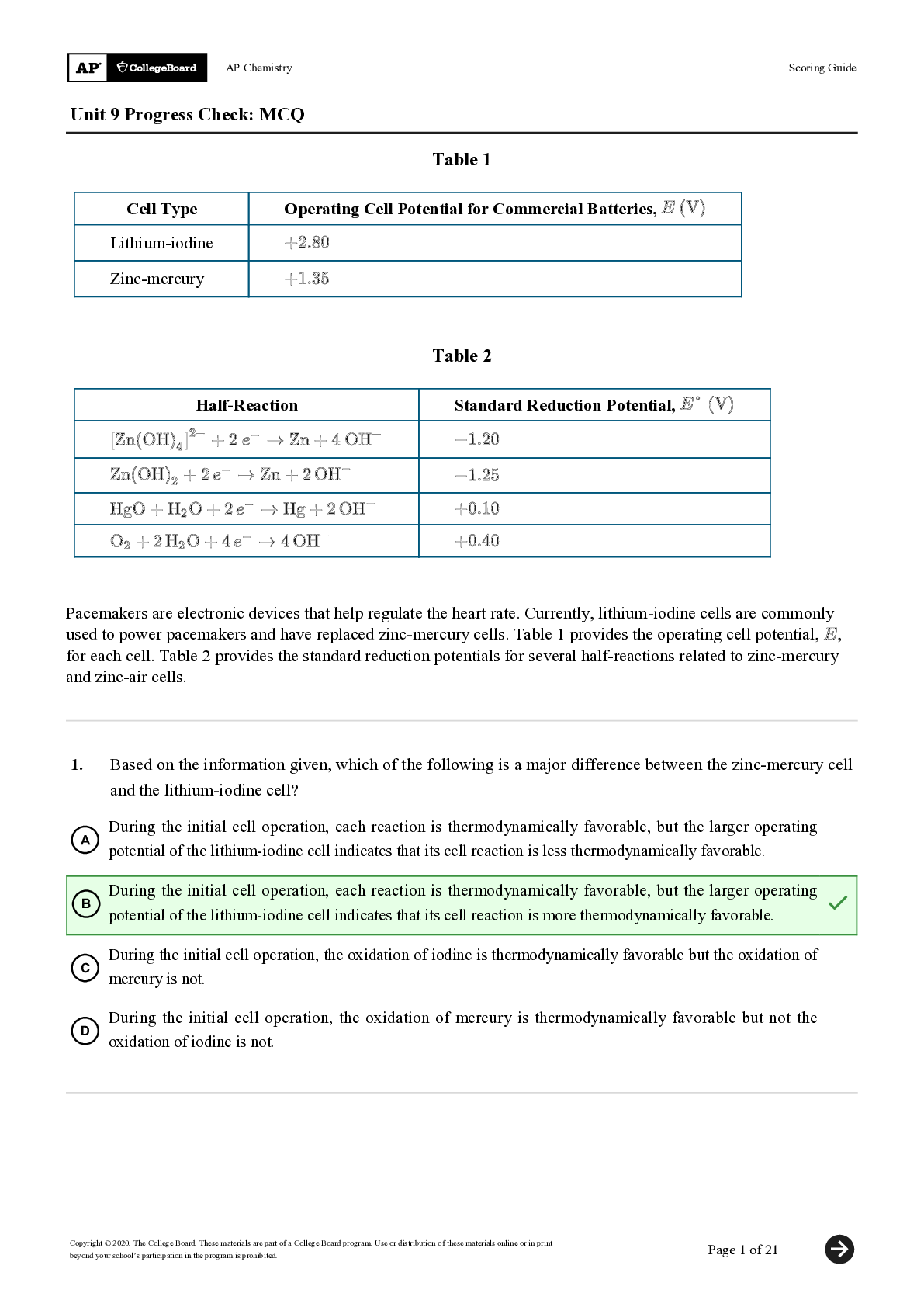
Reviews( 0 )
Document information
Connected school, study & course
About the document
Uploaded On
Apr 20, 2021
Number of pages
21
Written in
Additional information
This document has been written for:
Uploaded
Apr 20, 2021
Downloads
0
Views
207











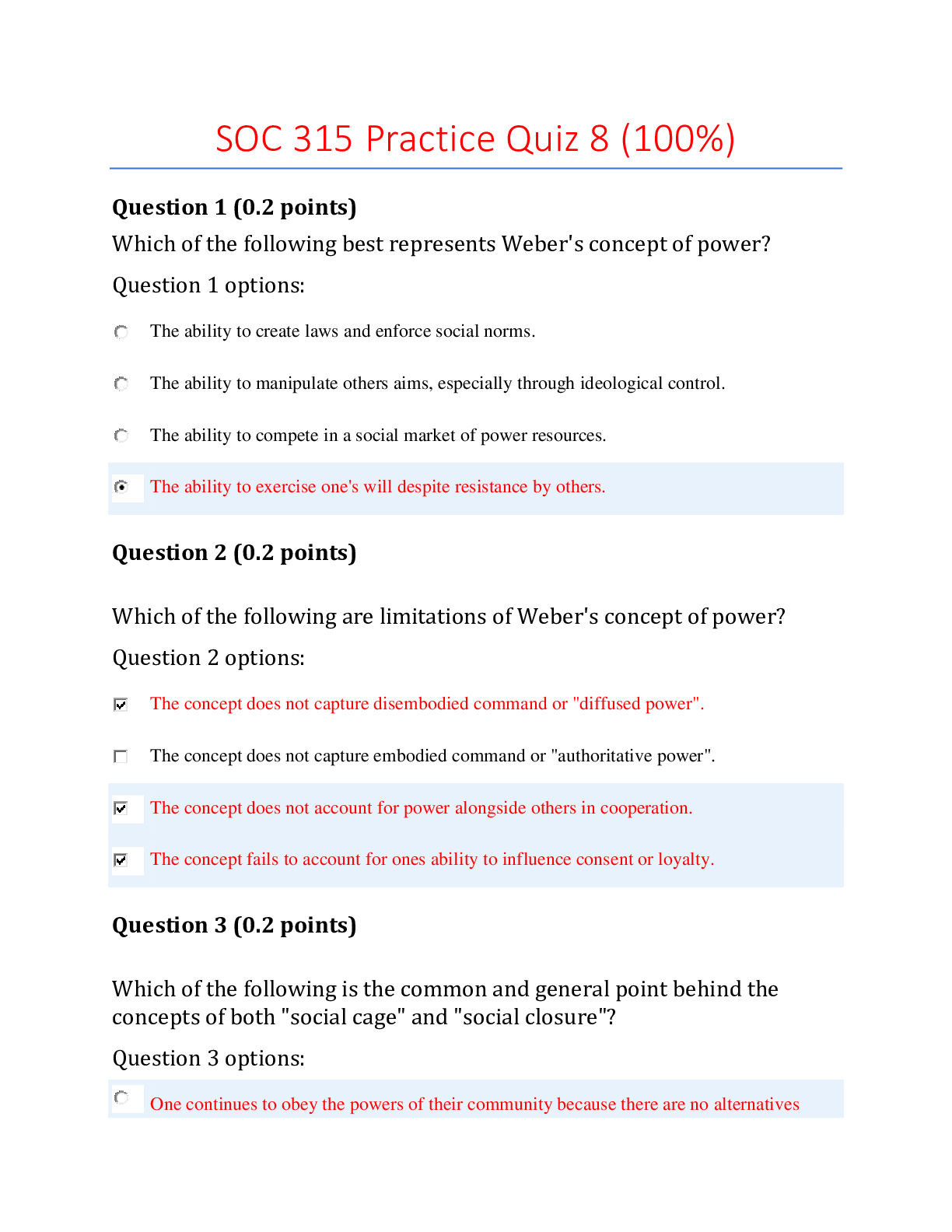

.png)

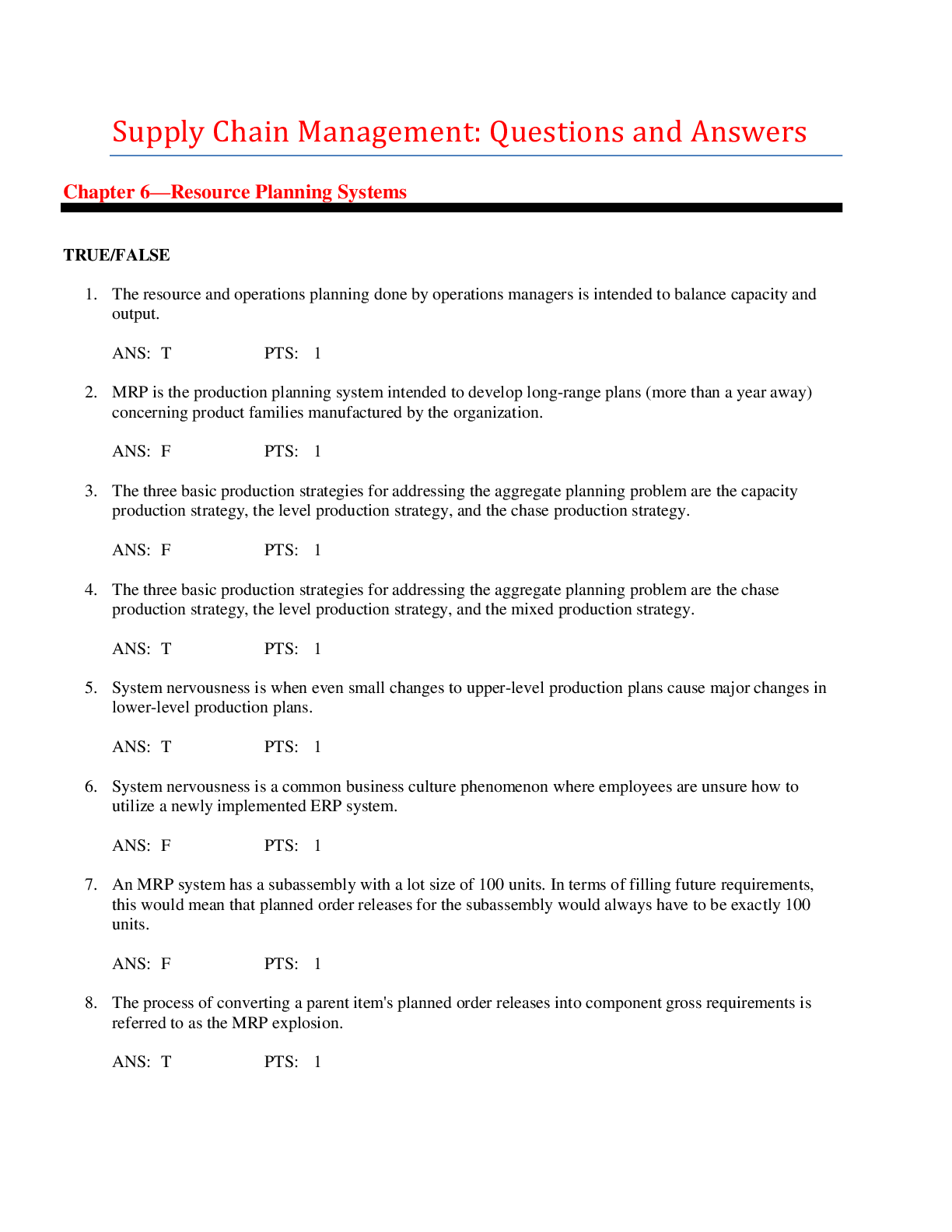
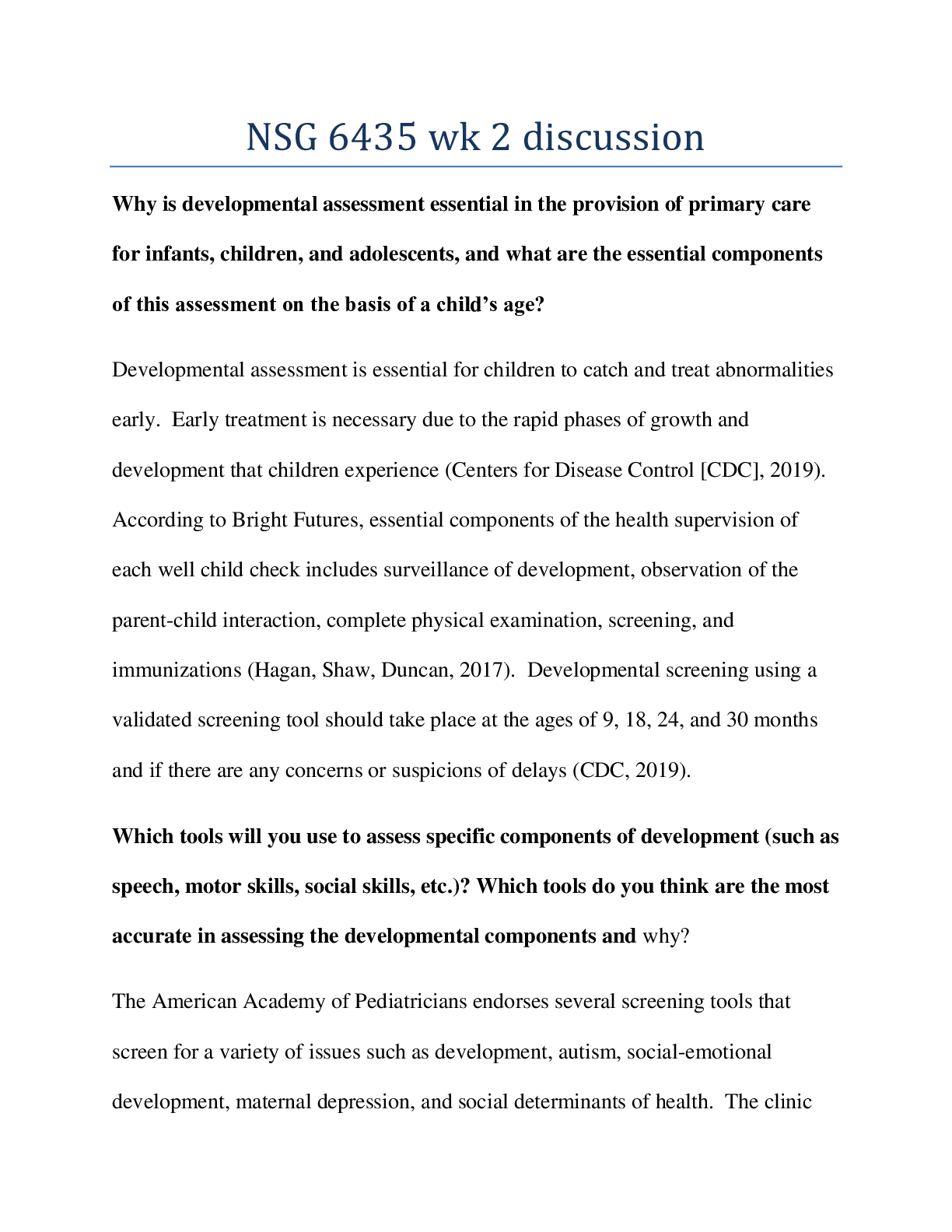
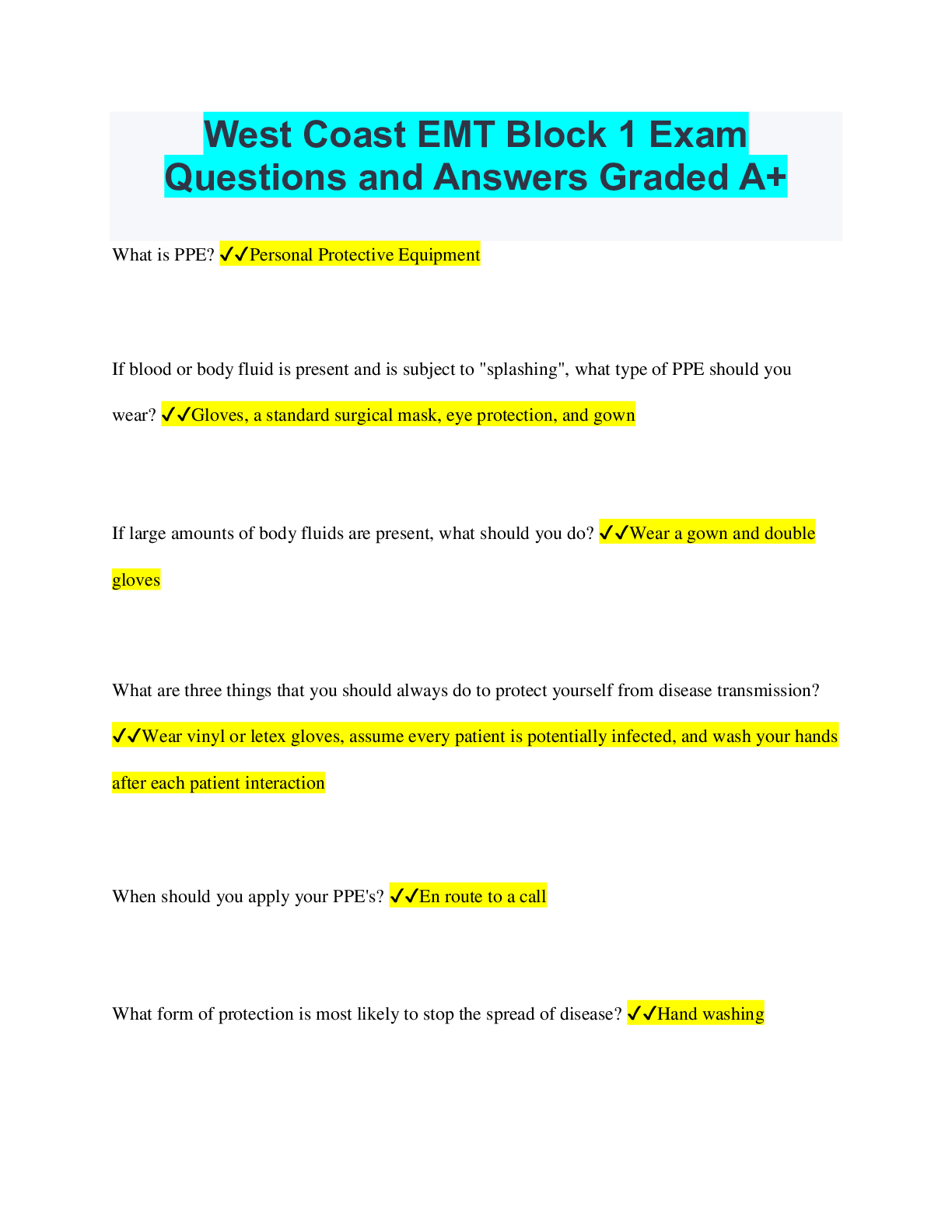

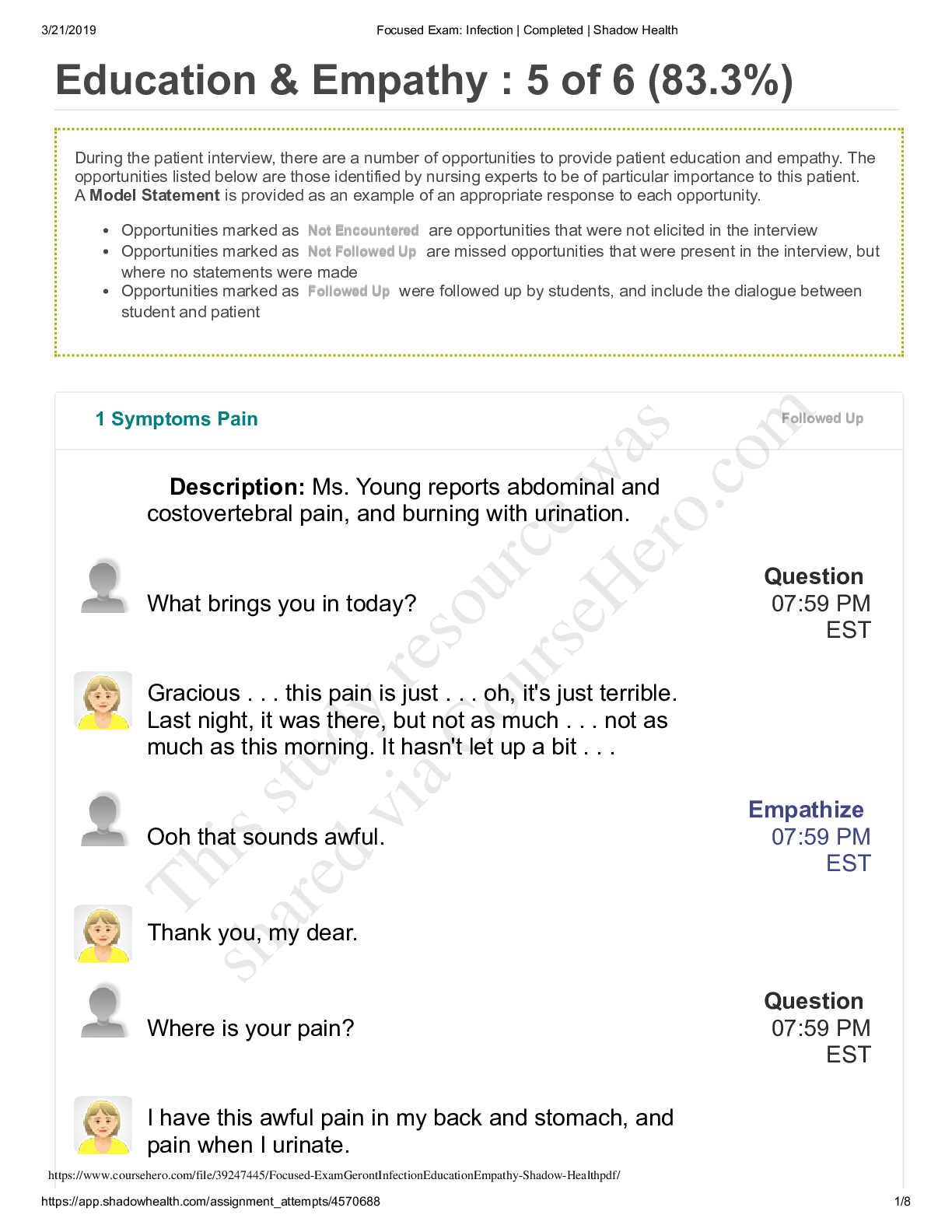

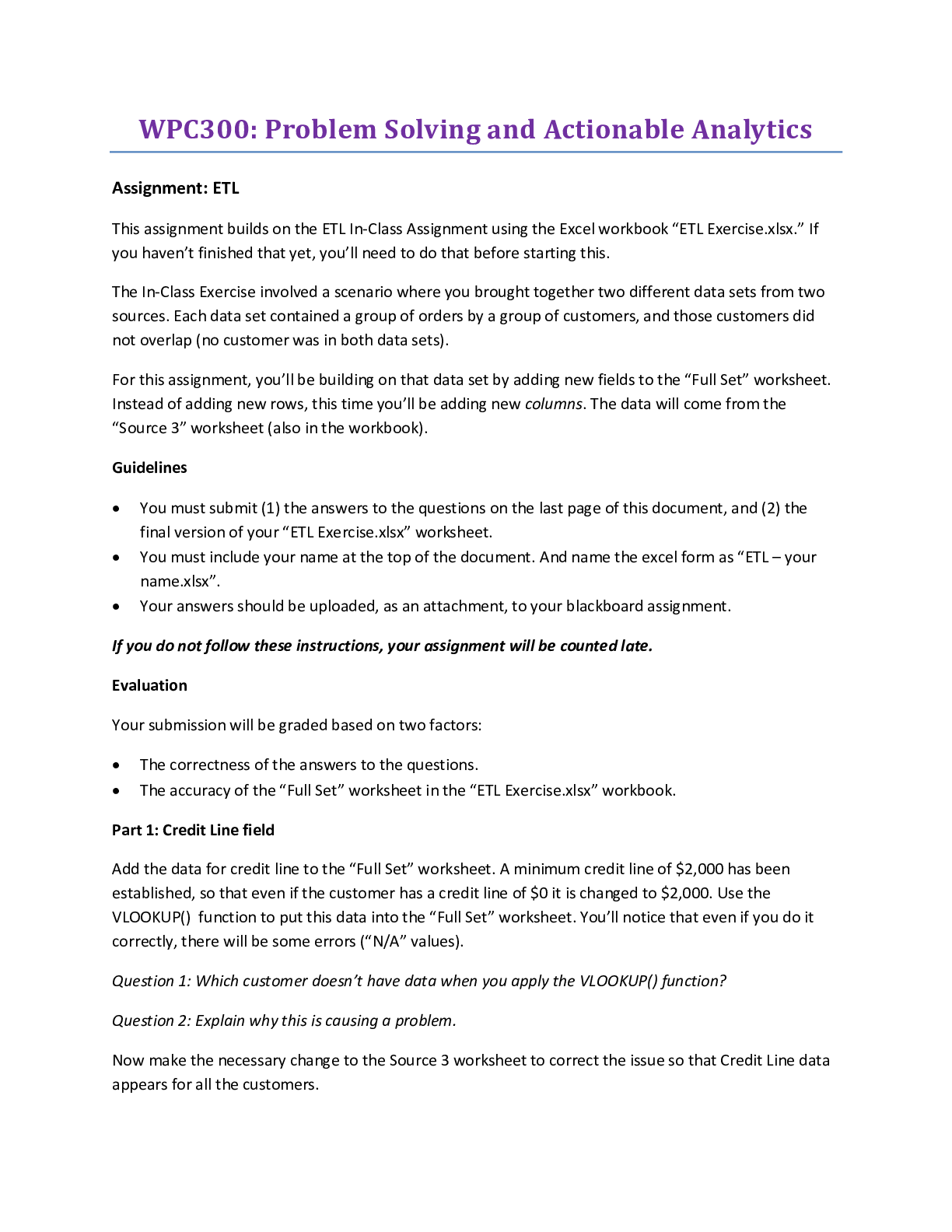
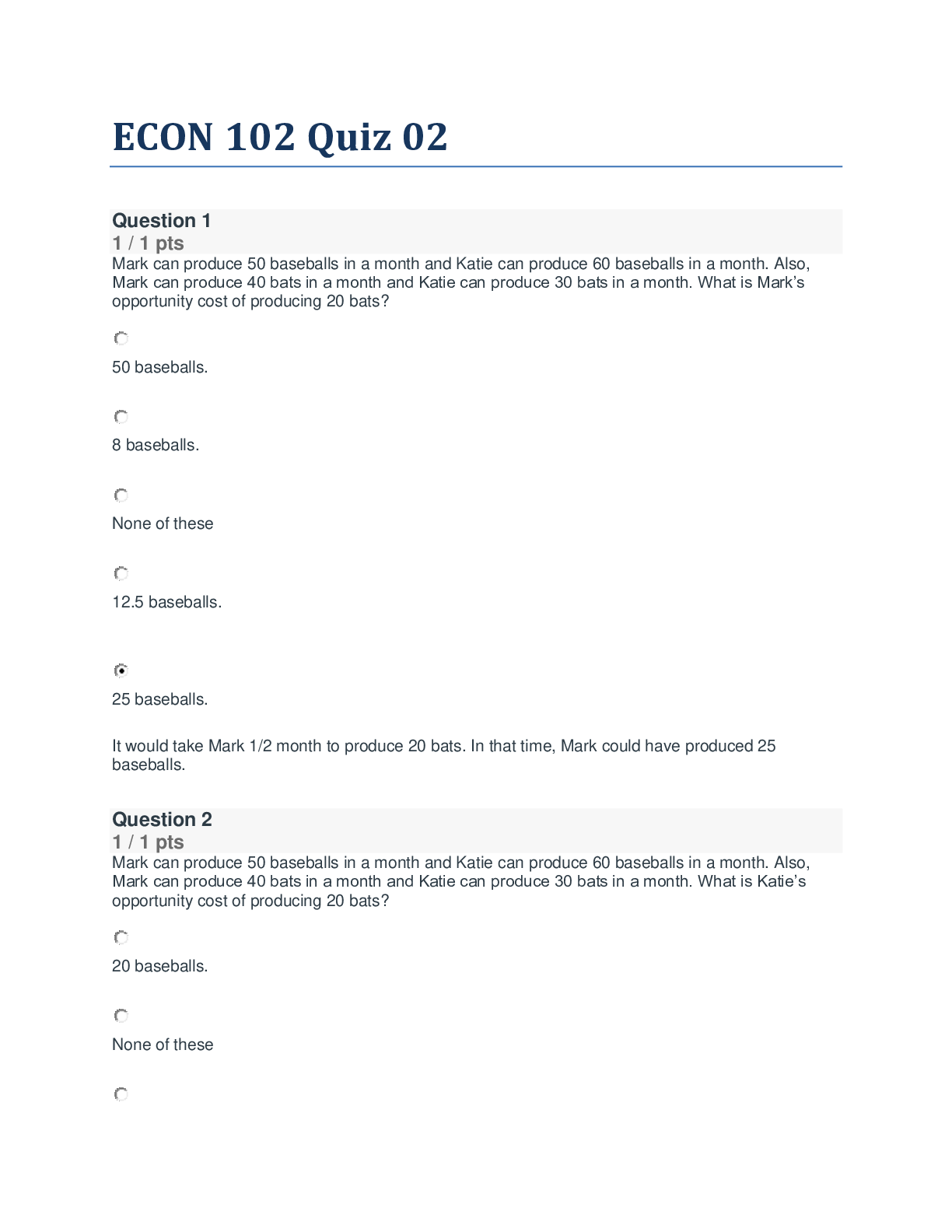
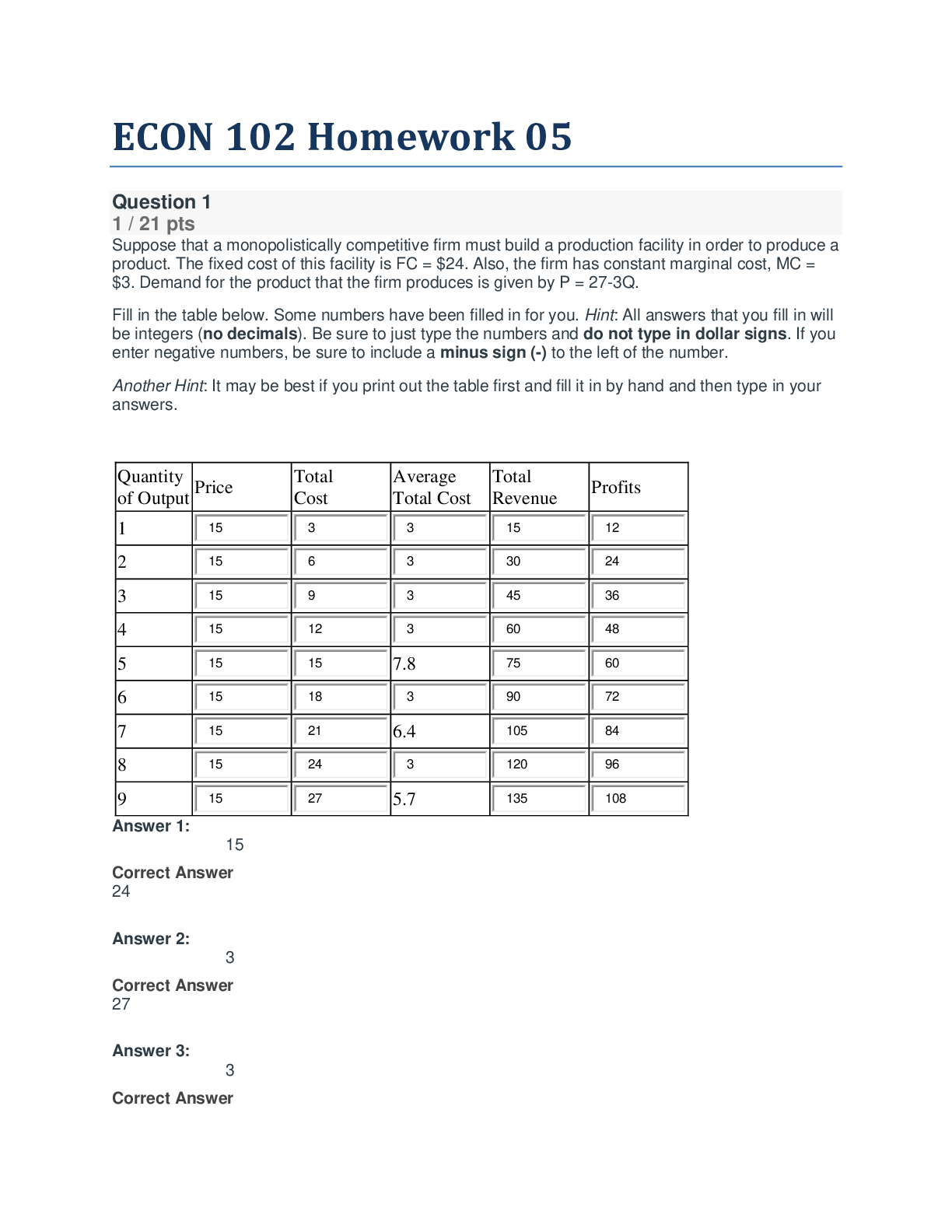
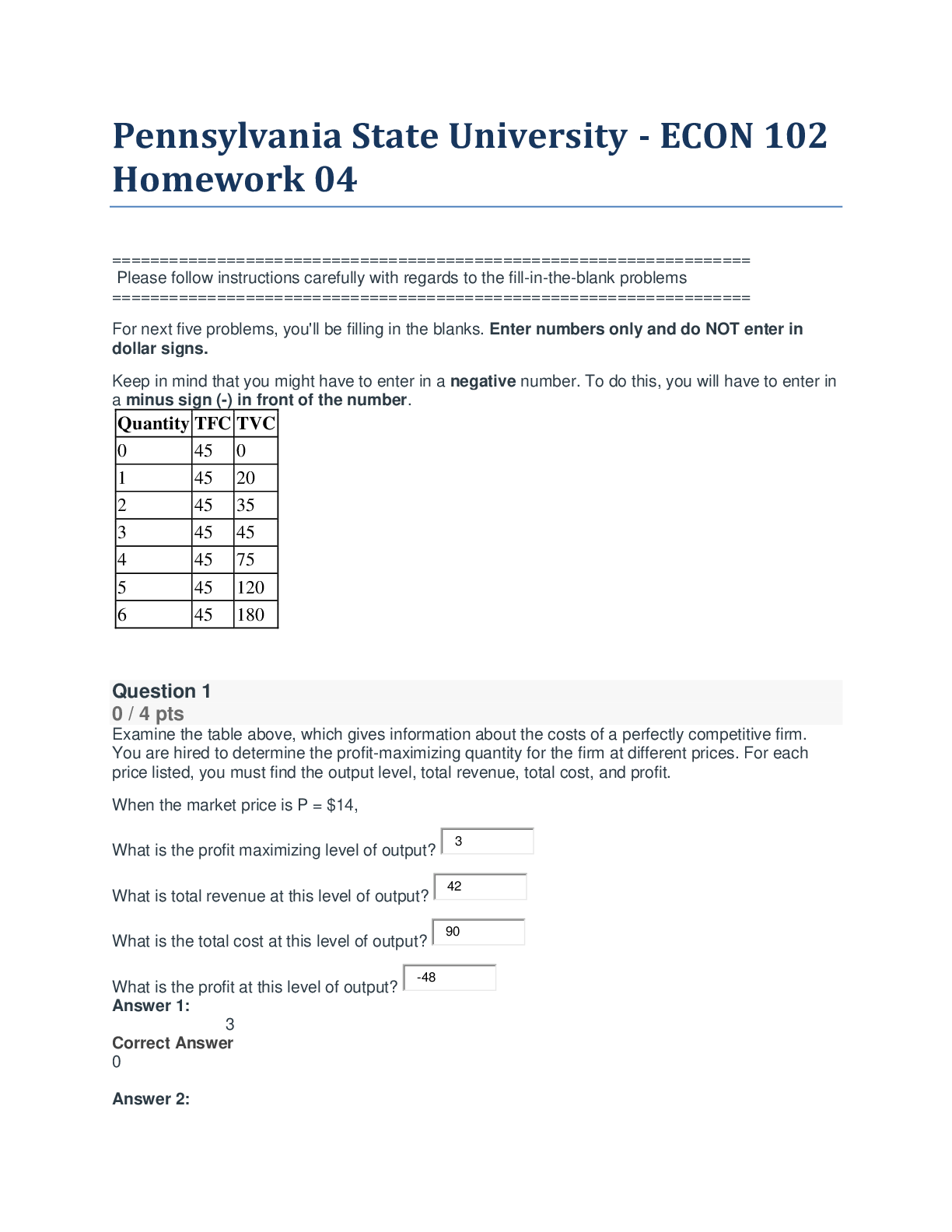
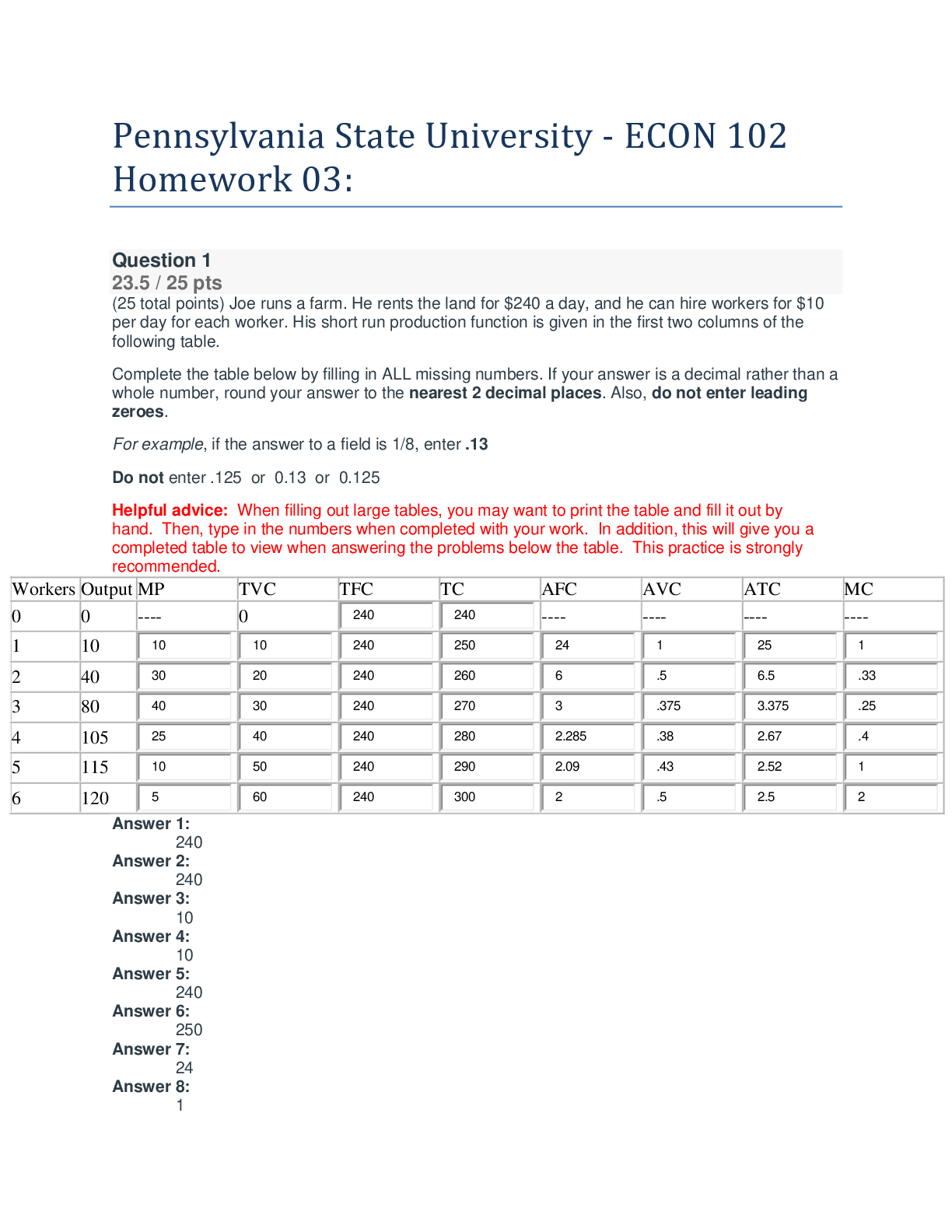
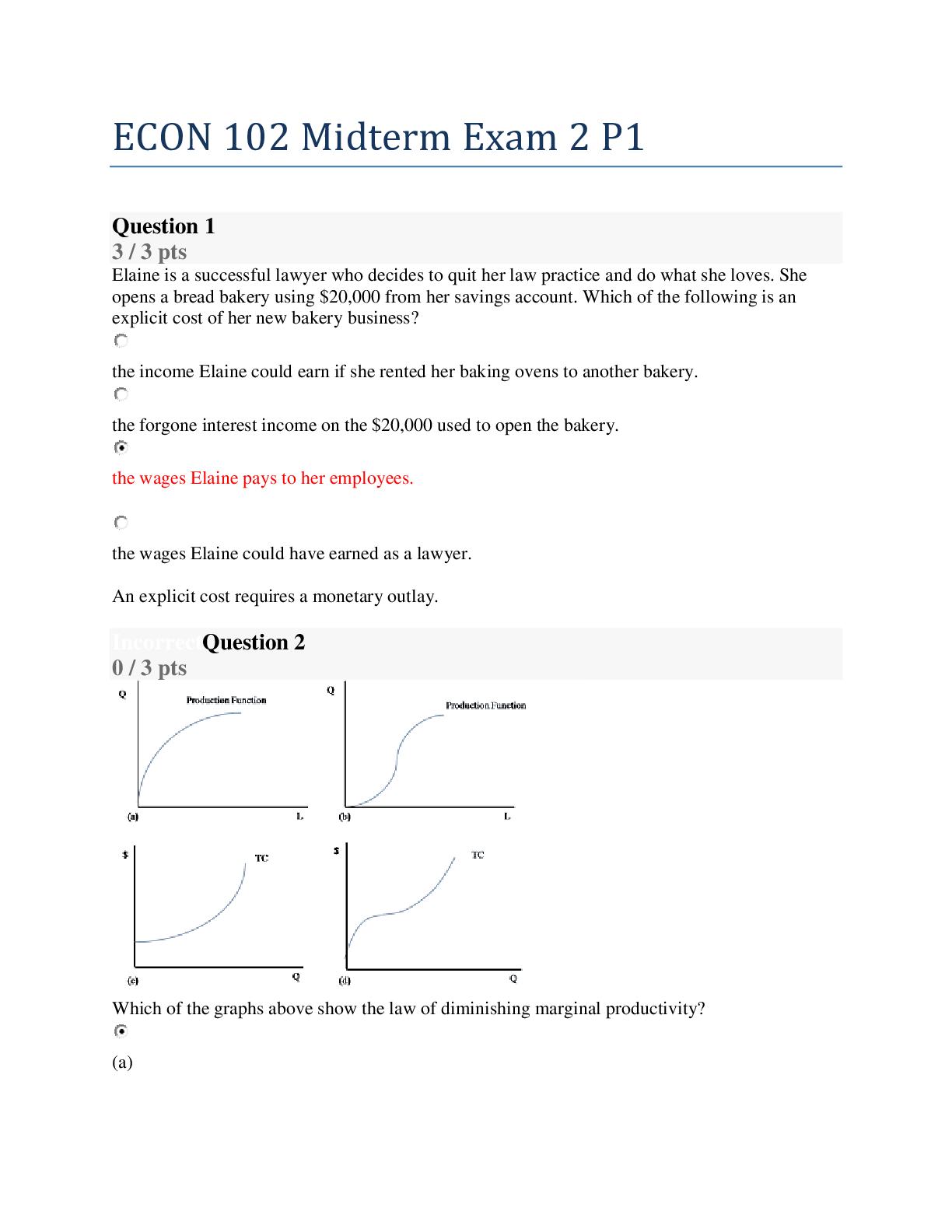
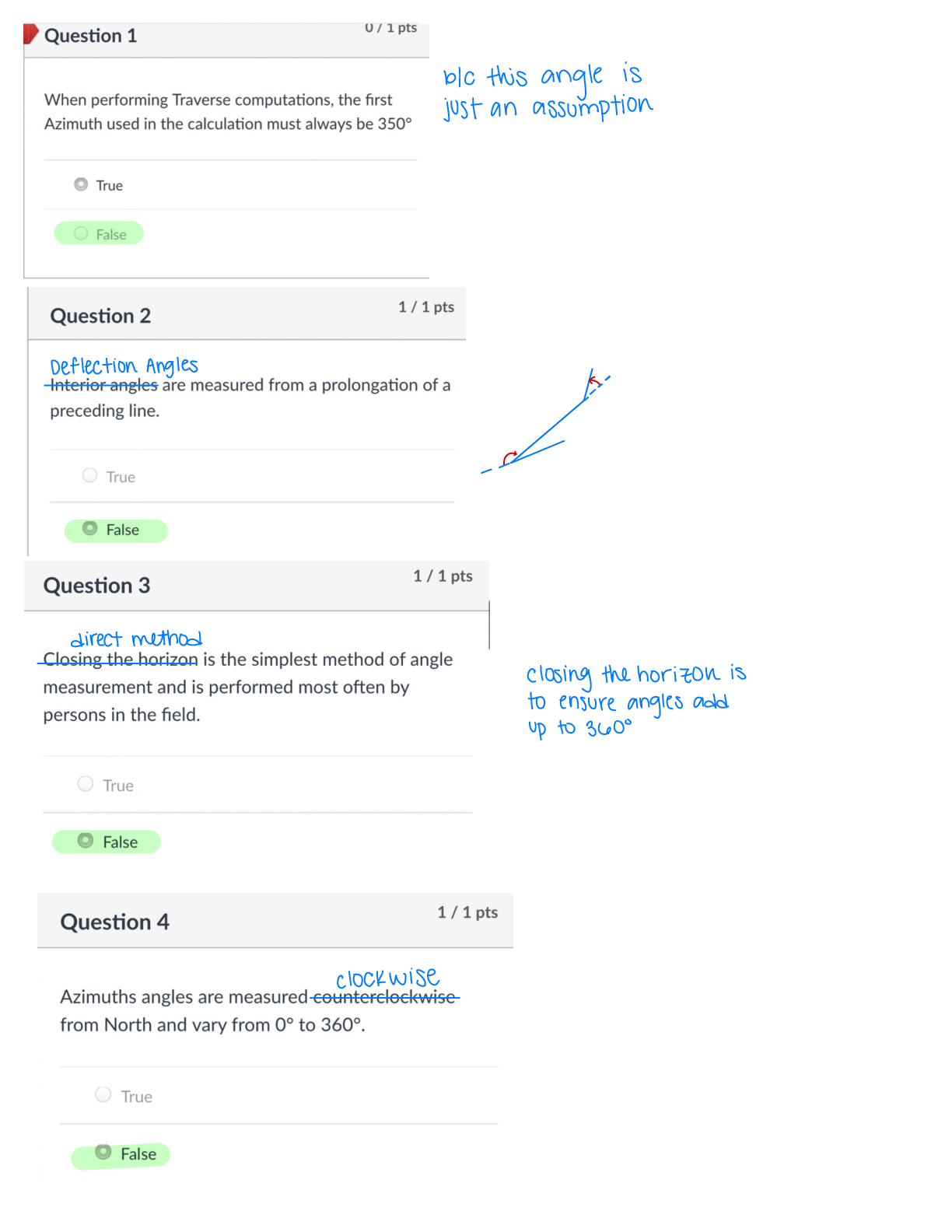
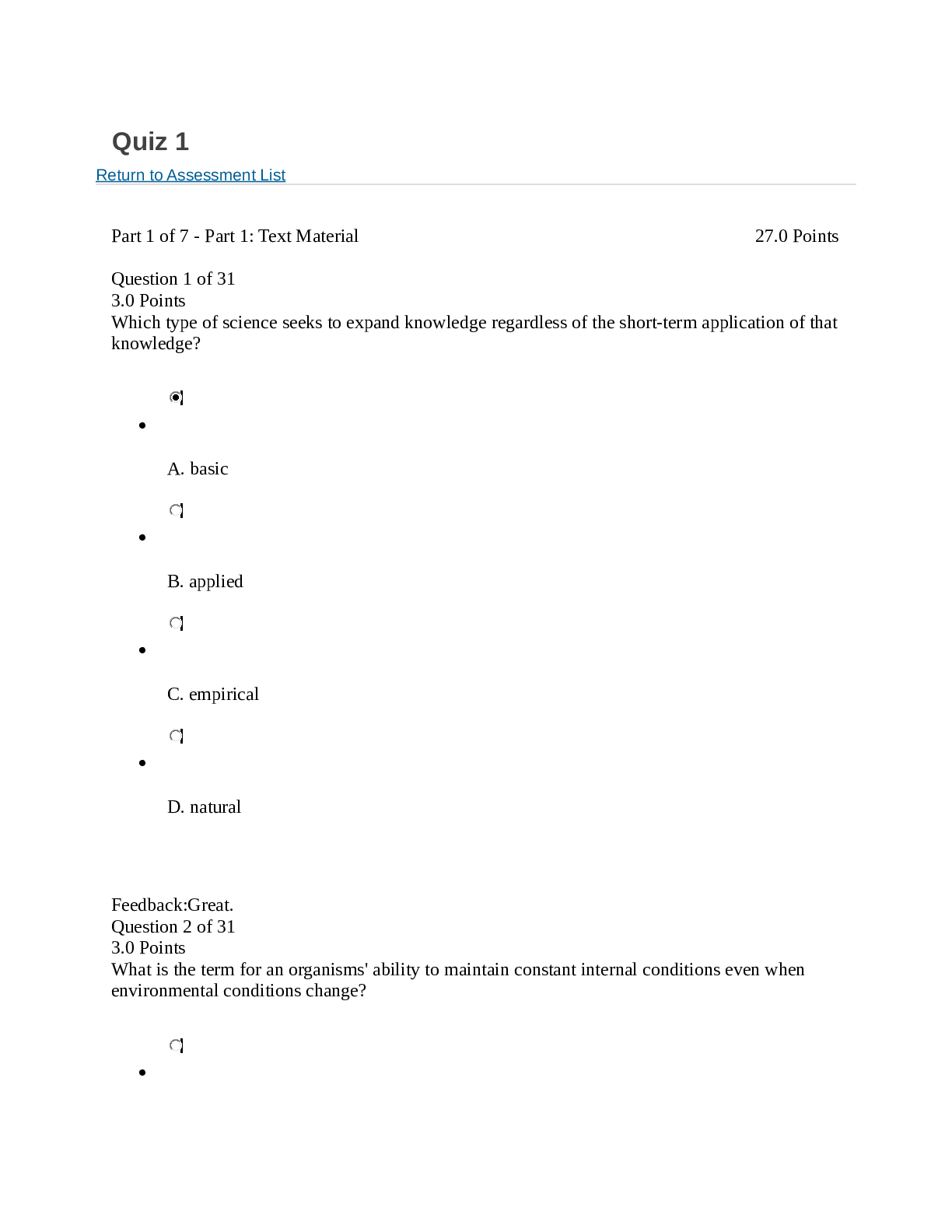

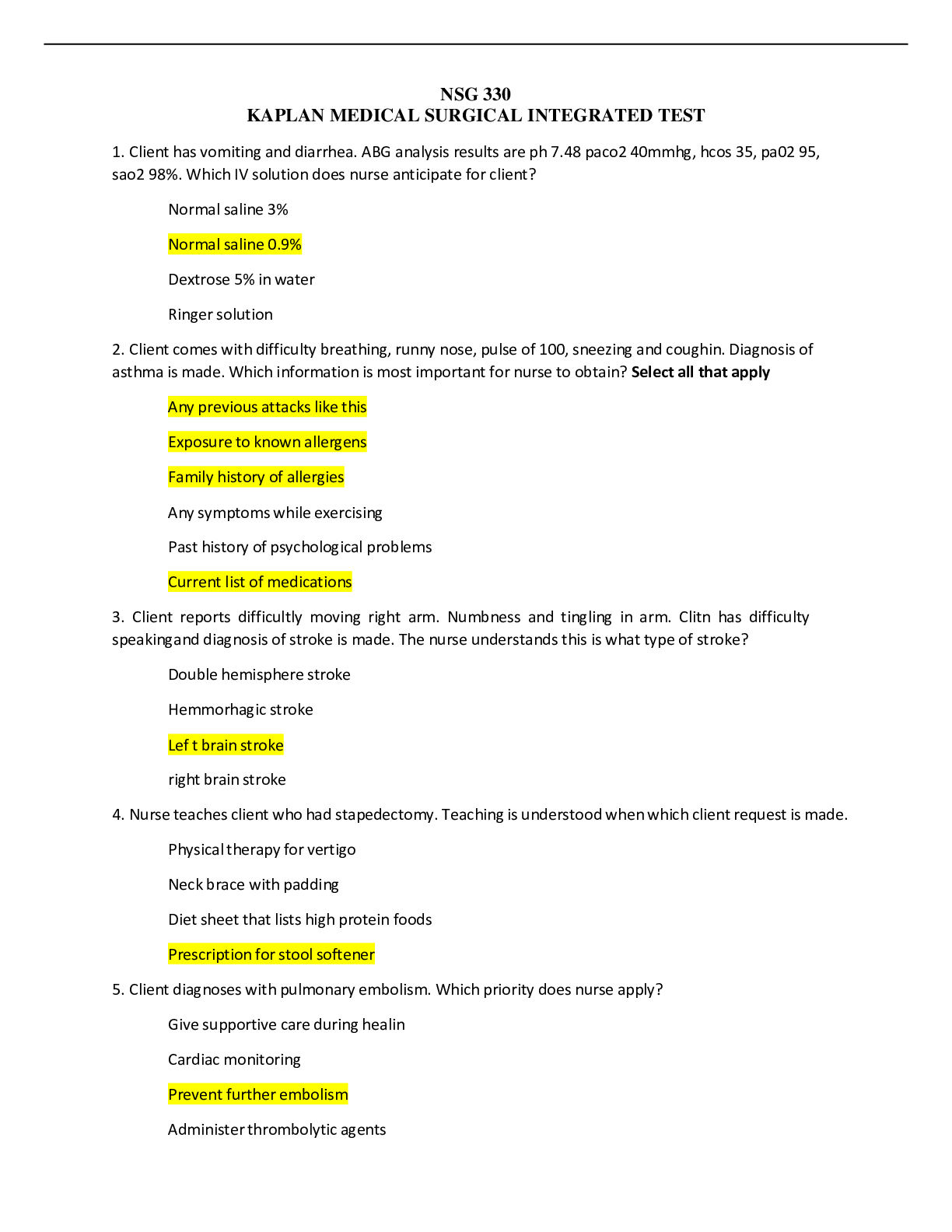
 Correct Study Guide, Download to Score A.png)
 Correct Study Guide, Download to Score A.png)
 Correct Study Guide, Download to Score A.png)
 Correct Study Guide, Download to Score A.png)

.png)

